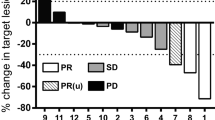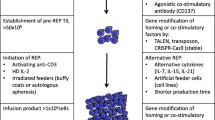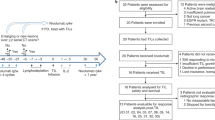Abstract
Tumour infiltrating lymphocytes (TIL) were isolated and expanded from biopsy samples of 4 patients with metastatic melanoma. The patients were treated with autologous expanded TIL and continuous or bolus infusion of Interleukin 2 (IL-2) at a dose of 18 × 106 International Units/m2/day for 5 days starting 36–48 hours after administration of cyclophosphamide at a dose of 1 g/m2. The number of TIL infused ranged from 1010 to 5,56 × 1010 cells. Two patients had stable disease (SD) lasting for 2 1/2 and 4 months respectively and they died 24 and 13 months after therapy. One patient died during therapy due to a pseudomonas septicaemia and another patient developed progressive disease (PD). He died 3 months after the start of therapy. The side effects were substantial but most of them were reversible upon cessation of the treatment.
The majority of the expanded TIL of all patients were of the CD8+ phenotype. Cutaneous metastases from two patients, removed after treatment with IL-2 and TIL, showed moderate lymphocytic infiltration also mainly of CD8+ T cells.
The treatment with IL-2 and TIL is feasible, but further investigations should continue in an attempt to improve the efficacy of the therapy, to reduce toxicity and to diminish the costs and labour of the culture methods.
Similar content being viewed by others
Abbreviations
- ICAM-1:
-
intercellular adhesion molecule 1
- IFN-g:
-
interferon-gamma
- IL-2:
-
interleukin-2
- IU:
-
international units
- LAK:
-
lymphokine activated killer cells
- TIL:
-
tumour infiltrating lymphocytes
References
Svennevig JL, Closs O, Harboe M et al. Characterization of lymphocytes isolated from non lymphoid human malignant tumours. Scan J Immunol 1987; 7: 487–93.
Poppema S, Bröckner EB, de Ley et al.In situ analysis of the mononuclear cell infiltrate in primary malignant melanoma of the skin. Clin Exp Immunol 1983; 51: 77–82.
Bröcker EB, Kolde G, Steinhausen D et al. The pattern of the mononuclear infiltrate as a prognostic parameter in flat superficial spreading melanomas. J Cancer Res Clin Oncol 1984; 107: 48–52.
Kradin RL, Kurnick JT, Lazarus DS et al. Tumour infiltrating lymphocytes and interleukin-2 in treatment of advanced cancer. Lancet 1989; 1: 577–80.
Rosenberg SA, Spies P, Lafreniere R. A new approach to the adoptive immunotherapy of cancer with tumor infiltrating lymphocytes. Science 1986; 223: 1318–21.
Rosenberg SA, Packard BS, Aeborsold PM, et al. Use of tumor-infiltrating lymphocytes and interleukin-2 in the immunotherapy of patients with metastatic melanoma. A Preliminary Report. New Eng J Med 1988; 319: 1676–80.
Topalian SL, Muul LM, Solomon D et al. Expansion of human tumor infiltrating lymphocytes for use in immunotherapy trials. J Immunol Methods 1987; 102: 127–41.
Topalian S, Solomon D, Avis FP et al. Immunotherapy of patients with advanced cancer using tumor-infiltrating lymphocytes and recombinant interleukin-2: a pilot study. J Clin Oncol 1988; 6: 839–53.
Rosenstein M, Yron J, Kaufmann Y et al. Lymphokine-activated killer cells: lysis of fresh syngeneic natural killer resistant murine tumor cells by lymphocytes cultured in interleukin-2. Cancer Res 1984; 44: 1946–53.
Grimm EA, Ramsey KM, Mazumder A et al. Lymphokine-activated killer cell phenomenon II. The precursor phenotype is serologically distinct from peripheral T lymphocytes, memory cytotoxic thymus-derived lymphocytes, and natural killer cells. J Exp Med 1983; 147: 884–97.
Belldegrun A, Muul LM, Rosenberg SA: Interleukin-2 expanded tumor infiltrating lymphocytes in human renal cell cancer isolation, characterization and anti-tumor activity. Cancer Research 1988; 48: 206–14.
Muul LM, Spies PJ, Director EP et al. Identification of specific cytolytic immune responses against autologous tumor in humans bearing malignant melanoma. J Immunol 1987; 138: 989–95.
Fisher B, Packard BS, Read EJ et al. Tumor localisation of adoptively transferred melanoma indium-111 labeled tumor infiltrating lymphocytes in patients with metastatic melanoma. J Clin Oncol 1989; 7: 250–61.
Eberlein TJ, Rosenstein M, Rosenberg SA. Regulation of a disseminated syngeneic solid tumor by systemic transfer of lymphoid cells expanded in interleukin-2. J Exp Med 1982; 150: 385–97.
Shu S, Rosenberg SA. Adoptive immunotherapy of a newly induced sarcoma: immunologic characteristics of effector cells. J Immunol 1985; 135: 2895–8.
Berendt MJ, North RJ. T cell mediated suppression of anti-tumour immunity: an explanation for progressive growth of an immunogenic tumor. J Exp Med 1980; 151: 69–80.
Peters LC, Brandhorst JS, Hanna MG Jr. Preparation of Immunotherapeutic autologous tumour cell vaccines from solid tumor. Cancer Research 1979; 39: 1353–60.
West WH. Continuous infusion of recombinant Interleukin-2 (rIL-2) in adoptive cellular therapy of renal cell carcinoma and other malignancies. Cancer Treat Rev 1989; 16 sup A: 83–9.
Eberlein TJ, Schoof DD, Jung SE et al. Interleukin-2 and lymphokine activated killer cells. Efficacy without toxicity. Arch Intern Med 1988; 148: 2571–6.
Giard DJ, Aaronson SA, Todaro GJ et al. In vitro cultivation of human tumors: establishment of cell lines derived from a series of solid tumors. J Natl Cancer Inst., 1973; 51: 1417–23.
De Jong R, Brouwer M, Rebel VJ et al. Generation of alloreactive cytolytic T lymphocytes by immobilized anti-CD3 monoclonal antibodies. Immunology 1990; 70: 357–64.
Bar MH, Sznol M, Atkins MB et al. Metastatic malignant melanoma treated with combined bolus and continuous infusion interleukin-2 and lymphokine activated killer cells. J Clin Oncol, 1990; 1138–47.
Amer JH, Gagne GM, Garcia AM et al. Preferential homing of tumor infiltrating lymphocytes in tumor-bearing mice. Cancer Immunol Immunother 1989; 29: 93–100.
Knazek RA, Wu YW, Aeborsold PM et al. Culture of human infiltrating lymphocytes in hollow fiber bioreactors. Journal of Immunological Methods 1990; 127: 29–37.
Nijhuis EWP, v.d. Wiel v. Kemenade E, Figdor CG et al. Activation and expansion of tumour infiltrating lymphocytes by anti-CD3 and anti-CD28 monoclonal antibodies. Cancer Immunol Immunother 1990; 32: 245–50.
Thiele DL, Lipsky PE. The role of cell surface recognition structures in the initiation of MHC-unrestricted “promiscuous” killing by T cells. Immunology Today 1989; 10: 375–81.
Kawakami J, Rosenberg SA, Lotze MT: Interleukin 4 promotes the growth of tumor-infiltrating lymphocytes cytotoxic for human autologous melanoma. J Exp Med 1988; 168: 2183–91.
Wang JL, Si LS, Karbout A et al. Lymphocytes infiltrating human ovarian tumors: synergy between tumor necrosis factor alpha and interleukin-2 in the generation of CD8+ effectors from tumor infiltrating lymphocytes. Cancer Res 1989; 49: 5979–85.
Whiteside TL. Human tumor-infiltrating lymphocytes and their characterization. In: Lotzova E, Herberman RB, eds. Interleukin-2 and Killer Cells in Cancer. Boca Raton, Florida: CRC Press, Inc., 1990: 133–51.
Parmiani G, Anichini A, Fossati G. Review. Cellular immune response against autologous human malignant melanoma: Are studies providing a frame-work for a more effective immunotherapy? J Natl Cancer Inst 1990; 82: 361–70.
Springer TA. Adhesion receptors of the immune system. Nature 1990; 346: 425–34.
Cohen PJ, Lotze MT, Roberts JR et al. The Immunopathology of Sequential Tumor Biopsies in Patients Treated with Interleukin-2. Correlation of Response with T-cells infiltration and HLA-DR expression. Am J Pathol 1987; 129: 208–16.
V. Duinen SG, Ruiter DJ, Broecker EB et al. Level of HLA antigens in locoregional metastases and clinical course of the disease in patients with melanoma. Cancer Research 1988; 48: 1019–25.
Anchini A, Mortarini R, Supino R et al. Human melanoma cells with high susceptibility to cell mediated lysis can be identified on the basis of ICAM-1 phenotype, VLA profile and invasive ability. Int. J. Cancer 1990; 46: 508–515.
Braakman E, Goedegebuure PS, Vreugdenhil RJ et al. ICAM-melanoma cells are relatively resistant to CD3-mediated T-cell lysis. Int. J. Cancer 1990; 46: 475–80.
Haybes BF, Telen MJ, Hale LP, Dennig SM. CD44-A molecule involved in leucocyte adherence and T cell activation. Immunology Today 1989; 10: 423–8.
Mitchell MS. Relapse in the central nervous system in melanoma patients successfully treated with biomodulators. J Clin Oncol 1989; 7: 1701–9.
Itoh K, Tilden AB, Balch CM. Interleukin-2 activation of cytotoxic T lymphocytes infiltrating into human metastatic melanomas. Cancer Res 1986; 46: 3011–7.
Ceuppens J, Goodwin J. Prostaglandins and the immune response to cancer. Anticancer Res (Review) 1981; 1: 71–8.
Mule JJ, Schwarz SL, Roberts AB et al. Transforming growth factor-beta inhibits thein vitro generation of lymphokine-activated killer cells and cytotoxic T cells. Cancer Immunol Immunother 1988; 26: 95–100.
Cochran AJ, Ren Wen D, Farzad Z et al. Immunosuppression by melanoma cells as a factor in the generation of metastatic disease. Anti-cancer Research 1989; 9: 859–64.
Mukkerji B, Wilhelm SA, Guha A et al. Regulation of cellular immune response against autologous human melanoma I. Evidence for cell-mediated suppression of in vitro cytotoxic immune response. J. Immunol 1986; 136: 1888–1892.
Lafreniere R, Borkenhagen K, Bryant LD et al. Tumor infiltrating lymphocytes in recombinant interleukin-2: enhancement of growth, cytotoxicity, and phenotypic ex pression of cytotoxic T cell antigens by cyclophosphamide given intravenously prior to tumor harvest. J Biol. Response Mod 1989; 8: 238–51.
Rosenberg SA, Aebersold P, Cornetta K et al. Gene transfer into humans- Immunotherapy of patients with advanced melanoma, using tumor-infiltrating lymphocytes modified by retroviral gene transduction. N Engl J Med 1990; 323: 570–8.
Nora R, Abrams JS, Trait NS et al. Myocardial toxic effects during recombinant interleukin-2 therapy. J Natl Cancer Inst. 1989; 81: 59–63.
Rosenberg SA, Schwarz SL, Spiess PJ. Combination immunotherapy for cancer: synergistic antitumor interactions of interleukin-2, alpha-interferon and tumor-infiltrating lymphocytes. J Natl Cancer Inst. 1988; 80: 1393–7.
Author information
Authors and Affiliations
Rights and permissions
About this article
Cite this article
Baars, J.W., Fonk, J.C.M., Scheper, R.J. et al. Treatment with tumour infiltrating lymphocytes and interleukin-2 in patients with metastatic melanoma: A pilot study. Biotherapy 4, 289–297 (1992). https://doi.org/10.1007/BF02172659
Received:
Accepted:
Issue Date:
DOI: https://doi.org/10.1007/BF02172659




